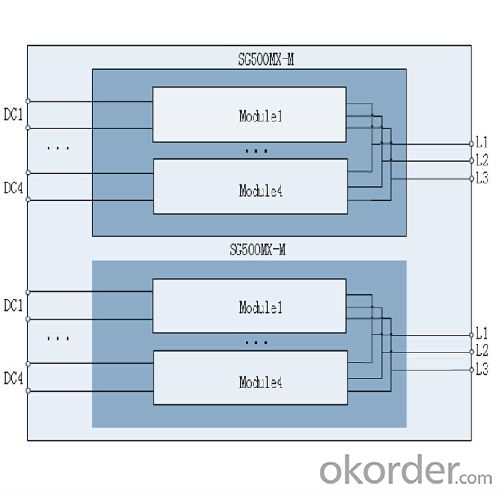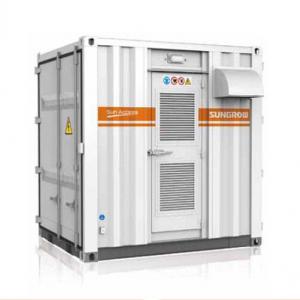3000 Watt Solar Inverter Photovoltaic On-Grid Connected Inverter SG1000TS-M PV Inverter
- Loading Port:
- China Main Port
- Payment Terms:
- TT or LC
- Min Order Qty:
- 500000 unit
- Supply Capability:
- 3000000 unit/month
OKorder Service Pledge
OKorder Financial Service
You Might Also Like
1. Structure of Photovoltaic On-Grid Connected Inverter SG1000TS-M PV inverter Description
A solar inverter, or PV inverter, or Solar converter, converts the variable direct current (DC) output of a photovoltaic (PV) solar panel into
autility frequency alternating current (AC) that can be fed into a commercial electrical grid or used by a local, off-grid electrical network.
It is acritical BOS–component in a photovoltaic system, allowing the use of ordinary AC-powered equipment. Solar inverters have
special functions adapted for use with photovoltaic arrays, including maximum power point tracking and anti-islanding protection.
Suitable for 50Hz/60Hz grid, could be used in Europe, Middle East Asia, Southeast Asia and Australia.
2. Main Features of the Photovoltaic On-Grid Connected Inverter SG1000TS-M PV inverter
• 7 square meters area for megawatt-class equipment
• Transport and installation by forklift, more flexible and economical
• Open door design of four sides, easy for installation and maintenance
• More flexible for inner devices overall replacement
• Efficient cooling patented design of combination inline and ventilation
• Patented structure design of inlet and outlet, effective dust proof
• Thick and efficient heat insulation layer
• Advanced three-level circuit structure improves product performance
• 8-MPPT, wide MPP voltage range, Flexible setting of 2 /4/ 8 MPPT
• Comprehensive modular ,Draw-type design
3. Photovoltaic On-Grid Connected Inverter SG1000TS-M PV inverter Images


4. Photovoltaic On-Grid Connected Inverter SG1000TS-M PV inverter Specification
Input (DC) |
|
Max. DC power (@ cos φ =1) | 1120kW |
Max. input voltage | 1000V |
Start voltage | 520V |
Min. working voltage | 500V |
Max. input current | 2280A |
MPPT voltage range | 500~850V |
Number of MPPTs | 2, 4, 8 |
Number of DC inputs | 2 x 8 |
|
|
Output (AC) |
|
Rated power | 1000kW |
Max. output AC power | 1100kVA |
Max. output current | 2036A |
THD | <3%(at nominal power) |
Nominal AC voltage | 315V |
AC voltage range | 252~362Vac |
Nominal grid frequency | 50Hz / 60Hz |
Grid frequency range | 47~52Hz / 57~ 62 Hz |
Power factor | >0.99@default value at nominal power, adj. 0.9 overexcited ~0.9 underexcited |
Isolated transformer | No |
DC current injection | <0.5% In |
|
|
Efficiency |
|
Max. efficiency | 98.80% |
European efficiency | 98.60% |
|
|
Protection |
|
DC disconnect device | Switch-disconnector with fuses |
AC disconnect device | Switch-disconnector with fuses |
DC overvoltage protection | Yes |
AC overvoltage protection | Yes |
Grid monitoring | Yes |
Ground fault monitoring | Yes |
Overheat protection | Yes |
Insulation monitoring | Yes |
|
|
General Data |
|
Dimensions(W×H×D) | 2991X2591X2438mm |
Weight | Containing DC Distribution Cabinet: 5169kg, Not Containing DC Distribution Cabinet: 4834kg |
Operating ambient temperature range | -35~+50℃ |
External auxiliary supply voltage | 380V |
Cooling method | Temperature controlled air-cooling |
Ingress protection rating | IP54 |
Allowable relative humidity range | 0~95%, non -condensing |
Max. operating altitude | 6000m (derating > 3000m) |
Communication port/protocols | Standard: RS485/ Modbus, Internet Options: CDT, DNP3.0, 101, 103, 104, GPRS/CDMA module |
5. FAQ of Photovoltaic On-Grid Connected Inverter SG1000TS-M PV inverter
Q1. What is the difference between inverter and solar inverter?
A1. Inverter only has AC inpput, but solar inverter both connect to AC input and solar panel, it saves more power.
Q2. What is the difference between MPPT&PWM?
A2. MPPT has higher efficiency, it can track the max power point and won't waste energy.
- Q: What is the maximum number of MPPT inputs in a solar inverter?
- The maximum number of MPPT inputs in a solar inverter can vary depending on the model and manufacturer. However, it is common to find solar inverters with a maximum of two or four MPPT inputs.
- Q: How does a solar inverter handle low light conditions?
- A solar inverter handles low light conditions by continuously monitoring the amount of sunlight received by the solar panels. When light levels drop, the inverter adjusts its operation to maximize power output by optimizing the voltage and current levels. It uses advanced algorithms and power electronics to convert the available sunlight into usable electricity efficiently, ensuring that even in low light conditions, the solar system continues to generate power.
- Q: Can a solar inverter be used in a solar-powered street lighting system?
- Yes, a solar inverter can be used in a solar-powered street lighting system. A solar inverter is responsible for converting the direct current (DC) produced by solar panels into alternating current (AC) that can be used to power the street lights. Therefore, it plays a vital role in ensuring that solar energy is efficiently utilized in the lighting system.
- Q: Can a solar inverter be used in three-phase systems?
- Yes, a solar inverter can be used in three-phase systems. In fact, there are specific three-phase solar inverters designed to convert the DC power generated by solar panels into AC power for utilization in three-phase electrical systems. These inverters are capable of efficiently managing the power flow and ensuring balanced distribution across all three phases.
- Q: What certifications should I look for when choosing a solar inverter?
- When choosing a solar inverter, it is important to look for certifications such as UL listing, IEC 61727 compliance, and IEEE 1547 compliance. These certifications ensure that the inverter meets safety and performance standards, and is compatible with grid connection requirements.
- Q: How does a solar inverter handle voltage transients?
- A solar inverter handles voltage transients by employing various protective mechanisms such as surge protection devices and voltage regulation techniques. These mechanisms help to stabilize and control the voltage level, ensuring that the inverter is not affected by sudden spikes or drops in voltage. Additionally, the inverter may include features like overvoltage and undervoltage protection, which help to prevent damage to the system during voltage transients.
- Q: How is the size of a solar inverter determined?
- The size of a solar inverter is typically determined by the total capacity of the solar panels it needs to handle. The inverter should have a capacity slightly higher than the total wattage of the solar panels to ensure efficient conversion of the DC power produced by the panels into usable AC power for household or grid consumption.
- Q: Can a solar inverter be used with a solar-powered data center?
- Yes, a solar inverter can be used with a solar-powered data center. A solar inverter is an essential component that converts the direct current (DC) generated by solar panels into usable alternating current (AC) electricity for powering electrical devices and systems, including data centers. By using a solar inverter, a solar-powered data center can efficiently utilize the renewable energy generated by solar panels to meet its power requirements.
- Q: Can a solar inverter be used with a wind turbine?
- Certainly! It is indeed possible to utilize a solar inverter alongside a wind turbine. Both wind turbines and solar panels generate direct current (DC) electricity, which necessitates conversion to alternating current (AC) in order to power the majority of household appliances and connect to the electrical grid. The primary function of a solar inverter is to convert DC electricity produced by solar panels into AC electricity. Interestingly, it can also perform the task of converting DC electricity generated by a wind turbine into AC electricity. However, it is worth mentioning that wind turbines typically produce higher voltage and fluctuating currents in comparison to solar panels. As a result, the inverter employed with a wind turbine may require specific design considerations to effectively manage these variations. Additionally, it is common for wind turbines to possess their own specialized inverters that are meticulously optimized to suit their unique electrical characteristics.
- Q: Can a solar inverter be used with a single solar panel?
- Yes, a solar inverter can be used with a single solar panel. The purpose of a solar inverter is to convert the direct current (DC) produced by the solar panel into alternating current (AC) that can be used to power electrical devices or be fed back into the grid. Whether you have one solar panel or multiple panels, a solar inverter is necessary to convert the DC electricity into usable AC electricity.
Send your message to us
3000 Watt Solar Inverter Photovoltaic On-Grid Connected Inverter SG1000TS-M PV Inverter
- Loading Port:
- China Main Port
- Payment Terms:
- TT or LC
- Min Order Qty:
- 500000 unit
- Supply Capability:
- 3000000 unit/month
OKorder Service Pledge
OKorder Financial Service
Similar products
Hot products
Hot Searches
Related keywords


























